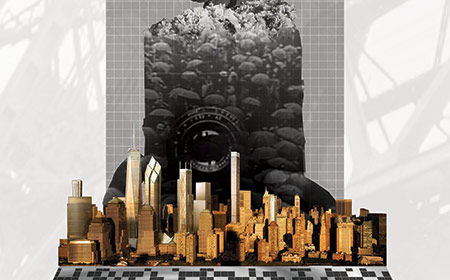Silent Film Sundays #2
If the urban cannot be understood as a totality, if it cannot genuinely be mobilized as the ‘scale’ of a global project, how can architects, spatial organisers and visual thinkers address its unavoidability?
‘Notations’ document the evolving means by which we visualise the urban through a series of visual and textual annotations. Part 1: Interpolation, looks at the ‘city’ undergoing the gradual replacement of representation within its total simulated envelopment. Four 20th century City Symphony Films are re-contextualized through digital and textual intertitles:
Manhatta (1921), by Charles Sheeler and Paul Strand, establishes the paradoxically disjunctive-yet-coherent nature of ‘montage’ as the characteristic technique and temporality of the ‘City Symphony’ genre. If the montage of the 20th century dismantles linear perspective in favor of disruptive-coherence, what dominant visual paradigms reveal the urban in the 21st?
De Brug (The Bridge) (1928), by Joris Ivens, helps us to look at a turn from manufacturing to financialization in a contemporaneous ‘postindustrial’ space. In what ways do technology and humanism meet in this infrastructural space?
Regen (Rain) (1929), by Joris Ivens, is a formal experiment that seeks to know the city through documenting a rainstorm. How does reflection, transparency and ambiguity help us to understand imaging in relation to the urban?
City in the Sun (1947) directed by Alasdair Loch, looks at depictions of the city as propaganda the city as both advertising art and modus vivendi. If the urban lives off its own self-promotion, what political forms are engendered in its excess?
Notations: Interpolation extends the provocation what is the urban?* through attempting to annotate its visual transformations. Conflicting temporalities, circulation and transparency, distanceless and financialized space can the products and processes of the urban be mapped within their emergent simulacra?
Doors @ 7:30 PM, screening @ 8:00 PM Approximate run time: 00:45:00
The Center for Image and Spatial Politics (CISP) investigates environments through the lens of composition. It asks how the world is organized and how the limits of organizational strategies govern and subjugate.
It has a double mission toward the production of critical inquiry and cultural production with the intent of uncovering the underlying structures that organize life.
*This screening was developed in and through conversations regarding the recent symposium hosted by architect, urbanist and writer Ross Adams, What is the Urban? Registers of a World Interior.

